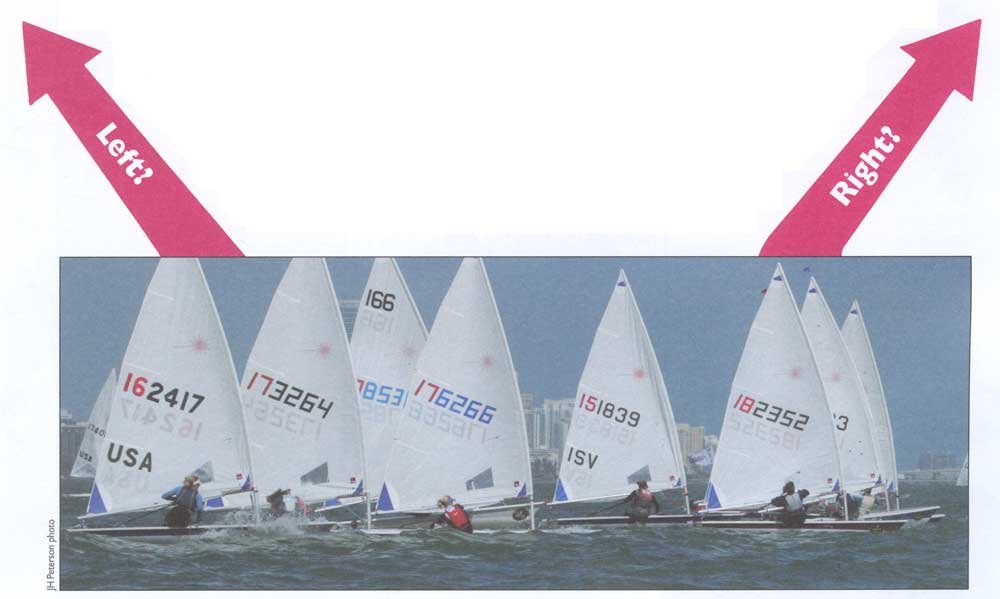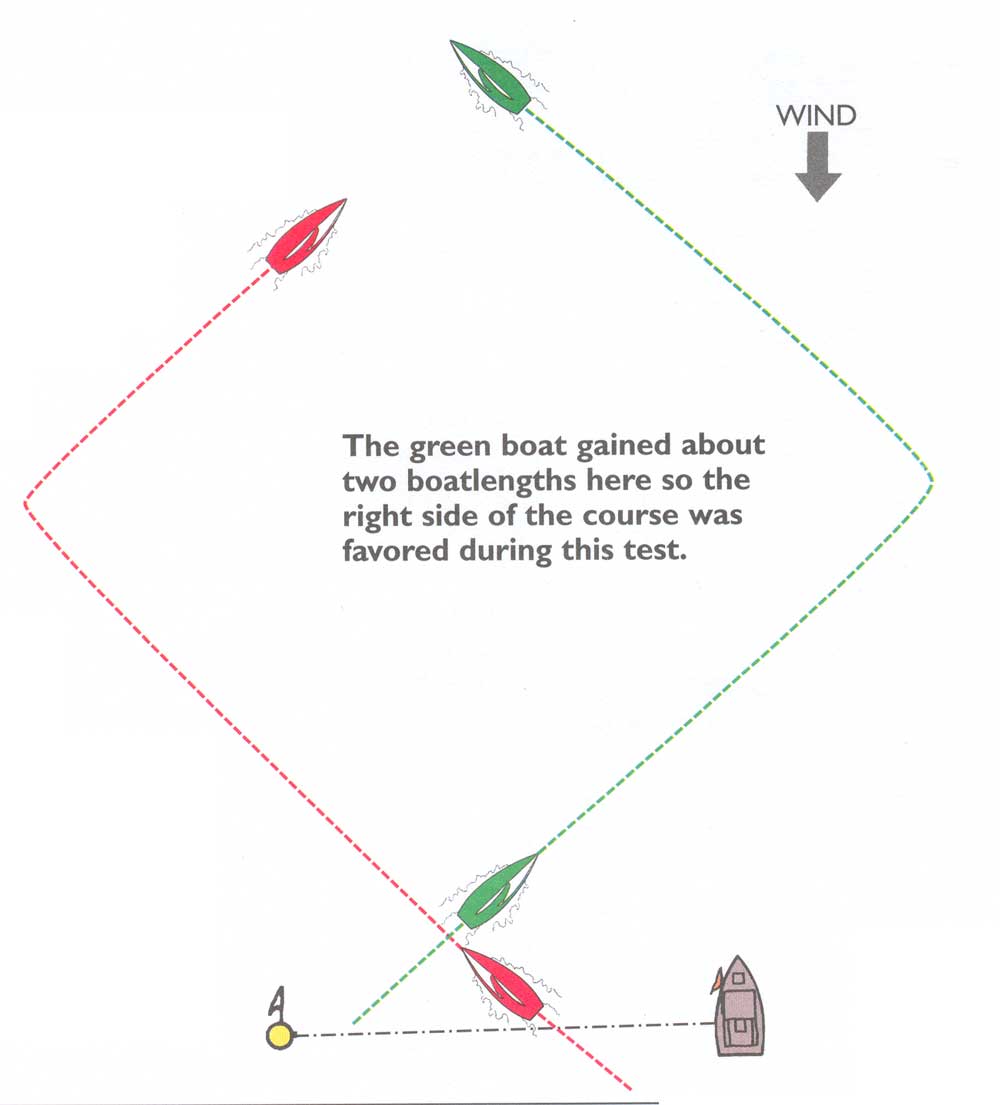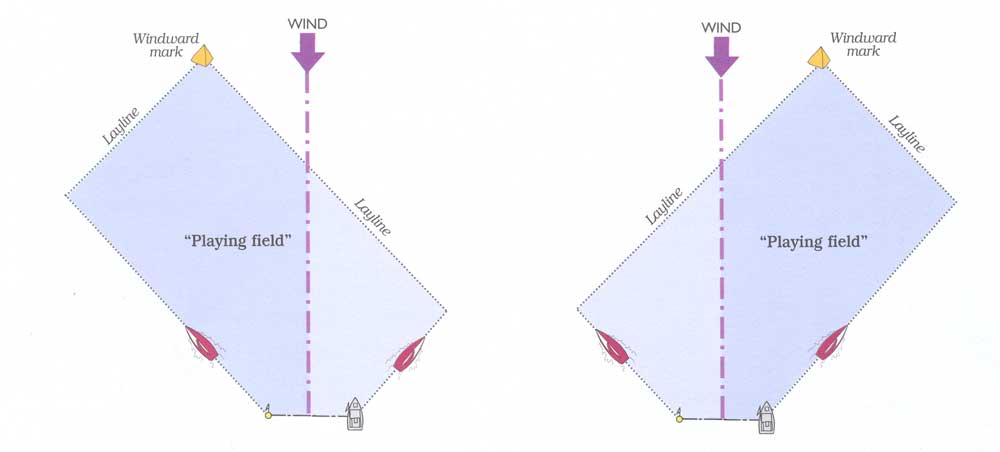by David Dellenbaugh
Here’s one way to approach the beginning of a race: Sail around in the starting area long enough to get a good line sight and figure out which end of the line is farther upwind. Start near that end, right on the line with clear air. Then look around to see which side of the course is better, and head that way.
I must admit I have started this way more than a few times, but I must also say
that it is completely backwards. That’s because, in most races, your position at
the first mark will be influenced much more by where you went on the first leg
than by where you were at the start. Therefore, your strategic plan for the
windward leg should have top priority.
Consider this typical example: The starboard end of the starting line is favored
by 5 to 7 degrees, so you start near the committee boat end because that means
you are already several boatlengths ahead of boats starting at the pin. You hit
the line with full speed and clear air. About a minute after the start you can
see more wind ahead (on the left side of the course) so you continue on
starboard tack. That was a good decision, but all the boats that started below
you on the line get into the better pressure sooner. By the windward mark, the
pin-end starters are 10 to 15 boatlengths ahead of you.
 |
| Should you go left or right? Or up the middle? The answer depends on a number of strategic factors that you must try to figure out before the start. The plan you make will then tell you how to approach the start. |
The moral of this story is that you should always try to figure out your
strategy for the windward leg first. Listen to predictions and observe the wind
direction, wind velocity, current and so on. Talk to local sailors before the
regatta, check the wind and weather on the web, and spend a lot of time sailing
around in the course area before the start.
After collecting all your data, decide whether you like the left or the right,
or possibly the middle. Then comes a very important step:
Figure out a starting plan that will let you follow the strategy you chose for
the windward leg.
If there is better pressure on the right, for example, you probably shouldn’t
start near the pin end. If you expect the wind direction to shift left, starting
at the committee boat is not a great idea.
Of course, there will be some times when you have no idea which side of the
first beat is favored. This actually happens fairly often, even with the best
sailors. When it does, what you need is a starting strategy that gives you
flexibility. Typically this means starting in the middle of the fleet. After the
start you can watch boats on each side of the course to see which ones are
gaining - then head that way.
 |
| Test the first beat with a partner. Even when you have time to sail around the entire racing area before the start, it’s hard to compare sides of the course by yourself. This is where a friendly ‘strategy partner’ can be very helpful. Begin by setting up a ‘rabbit start somewhere near where the starting line will be. One boat ducks behind the other and then both sail closehauled as fast as they can toward opposite sides of the windward leg.
|
There are a couple times when you might base your starting plan totally on which
end of the line is farther upwind. This would make sense when a) it seems like
the wind and other strategic factors will remain fairly steady up the first
beat; or b) one side may be favored slightly but it’s not enough to make up for
a skewed line.
| Check the course layout. The position of the starting line relative to the first mark often has a large impact on your starting plan. As soon as the race committee sets (or signals the position of) the windward mark, take a good look. Is the mark directly upwind of the starting line? Or will you spend more time on one tack than the other? |
|
 |
|
| In this situation, the windward mark has been placed to the left of the wind direction (or perhaps the wind shifted right). As a result, boats will spend more time on starboard tack, and most of the ‘playing field’ is to the left of the starting line. This will make the pin end of the line more advantageous. | Here the windward mark has been placed to the right of the wind direction (or the wind may have shifted to the left). As a result, boats will spend more time on port tack, and most of the ‘playing field’ is to the right of the starting line. This will make the committee boat end of the line more advantageous. |
Remember, the strategy you choose on the first leg usually has more of an effect
on your race results than where you started on the line. So pick your upwind
strategy first, and then execute a start to help you follow that plan.
Dave publishes the newsletter Speed & Smarts. For a subscription call:
800-356-2200 or go to:
www.speedandsmarts.com